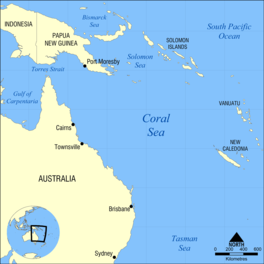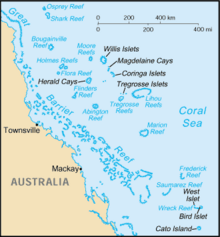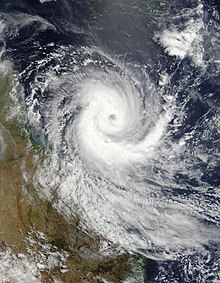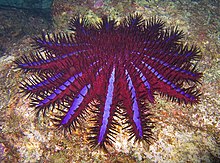Coral Sea
| Coral Sea | |
|---|---|
 | |
| Coordinates | 18°S 158°E / 18°S 158°E |
| Type | Sea |
| Basin countries | |
| Surface area | 4,791,000 km2 (1,850,000 sq mi) |
| Average depth | 2,394 m (7,854 ft) |
| Max. depth | 9,140 m (29,990 ft) |
| Water volume | 11,470,000 km3 (9.30×1012 acre⋅ft) |
| Settlements | Brisbane, Gold Coast, Sunshine Coast, Port Moresby, Cairns, Townsville, Nouméa |
| References | [1][2] |
The Coral Sea (French: Mer de Corail) is a
The sea contains numerous islands and
Geography
It is bounded in the west by the east coast of Queensland, thereby including the Great Barrier Reef, in the east by Vanuatu (formerly the New Hebrides) and by New Caledonia, and in the northeast approximately by the southern extremity of the Solomon Islands. In the northwest, it reaches to the south coast of eastern New Guinea, thereby including the Gulf of Papua. It merges with the Tasman Sea in the south, with the Solomon Sea in the north and with the Pacific Ocean in the east. On the west, it is bounded by the mainland coast of Queensland, and in the northwest, it connects with the Arafura Sea through the Torres Strait.[2]
The sea is characterised by its warm climate, with frequent rains and tropical cyclones.
Extent

While the
The International Hydrographic Organization defines the limits of the Coral Sea as follows:[3]
On the North. The South coast of New Guinea from the entrance to the Bensbach River (141°01'E) to Gadogadoa Island near its Southeastern extreme (10°38′S 150°34′E / 10.633°S 150.567°E), down this meridian to the 100 fathom line and thence along the Southern edges of Uluma Reef and those extending to the Eastward as far as the Southeast point of Lawik Reef (11°43.5′S 153°56.5′E / 11.7250°S 153.9417°E) off Tagula Island, thence a line to the Southern extreme of Rennell Island (Solomon Islands) and from its Eastern point to Cape Surville, the Eastern extreme of San Cristobal Island [Makira], Solomons; thence through Nupani Island, the Northwestern of the Santa Cruz Islands (10°04.5′S 165°40.5′E / 10.0750°S 165.6750°E) to the Northernmost Island of the Duff Islands (9°48.5′S 167°06′E / 9.8083°S 167.100°E).
On the Northeast. From the Northernmost island of the Duff Islands, through these islands to their Southeastern extreme, thence a line to Méré Lava,
Anatom Island (20°11′S 169°51′E / 20.183°S 169.850°E) in such a way that all the islands of these Groups, and the straits separating them, are included in the Coral Sea.On the Southeast. A line from the Southeastern extreme of Anatom Island to Nokanhoui (reefs) (22°46′S 167°34′E / 22.767°S 167.567°E) off the Southeast extreme of New Caledonia, thence through the East point of Middleton Reef to the Eastern extreme of Elizabeth Reef (29°55′S 159°02′E / 29.917°S 159.033°E) and down this meridian to Latitude 30° South.
On the South. The parallel of 30° South to the Australian coast. (Bordering the Tasman Sea.)
On the West. The Eastern limit of the Arafura Sea [The entrance to the Bensbach River (141°01'E), and thence a line to the Northwest extreme of York Peninsula, Australia (11°05′S 142°03′E / 11.083°S 142.050°E)] and the East Coast of Australia as far south as Latitude 30° South.
Geology
The fairly deep Coral Sea
The geological formation processes are still proceeding, as partly evidenced by the
The sea received its name because of its numerous coral formations. They include the GBR, which extends about 2,000 km (1,200 mi) along the northeast coast of Australia and includes approximately 2,900 individual reefs[11] and 1000 islands.[12] The Chesterfield Islands and Lihou Reef are the largest atolls of the Coral Sea.
Topography
To the east of the north Australian coast is the Great Barrier Reef on the continental shelf. To its east is a plateau that is host to the Coral Sea Islands Territory that is known as either the Coral Sea Plateau or the Queensland Plateau. To the north of the Great Barrier Reef the Eastern and Papuan Plateaus continue the southern continental shelf of
Hydrology

Major Coral Sea currents form a counter-clockwise gyro which includes the East Australian Current. It brings warm nutrient-poor waters from the Coral Sea down the east coast of Australia to the cool waters of the Tasman Sea. This current is the strongest along the Australian coasts and transforms 30 million m3/s of water within a flow band of about 100 kilometres wide and 500 metres deep. The current is strongest around February and weakest around August.[20]
The major river flowing into the sea is the Burdekin River, which has its delta southeast of Townsville. Owing to the seasonal and annual variations in occurrence of cyclones and in precipitation (typically between 200 and 1600 mm/year), its annual discharge can vary more than 10 times between the two succeeding years. In particular, in the period 1920–1999, the average flow rate near the delta was below 1000 m3/s in 1923, 1931, 1939, 1969, 1982, 1985, 1987, 1993 and 1995; it was above 25,000 m3/s in 1927, 1940, 1946, 1950, 1951, 1959, 1968, 1972, 1974 and 1991, and reached about 40,000 m3/s in 1946.[21] This irregularity results in concomitant fluctuations of the sea water composition near the river delta.
The surface water temperature varies on the south of the sea from 19 °C in August to 24 °C in February. It is rather warm and stable at 27–28 °С in the north all through the year. Water salinity is 34.5–35.5‰ (parts per thousand).[1] The water is mostly very clear, with the visibility of about 30 metres (100 ft) near the reefs.[11]
History
The Coral Sea takes its name from its coral formations of the Great Barrier Reef, the largest known reef system in the world.
In May 1942, a battle between Allied and Imperial Japanese naval units took place in the Coral Sea, which resulted in the prevention of the Japanese sea-borne invasion of Port Moresby.
Climate

The sea has a subtropical climate and is frequently hit by
Annual rainfall typically ranges between 1,000 and 3,000 mm depending on the area. Most rains fall between December and March, in bursts of 30–60 days.[22] The number of clear days per year varies approximately between 80 and 125, and the typical temperature variation through the year are 18–27 °C.[23]
Winds
Winds in the Coral Sea can be classified by season,
In January, the northwest monsoon may occur between the parallels of 15°S and 20°S, west of the 150°E meridian. Gales are rare in this region most of the year except for June–August, when strong southeasterly winds occur a few days per month.[25]
The southeasterly trades are also strong north of 15°S between March and November. They weaken and often change to westerly winds in December and to northerly and northwesterly winds in January and February.[25]
Flora
The Australian shore of the Coral Sea is mostly composed of sand. The GBR is too far away to provide significant coral deposits, but it effectively screens the coast from the ocean waves. As a result, most land vegetation spreads down to the sea,[26] and the coastal waters are rich in underwater vegetation, such as green algae.[27] The most common genera of seagrasses are Halophila and Halodule.[28]
The islands of the GBR contain more than 2,000 plant species, and three of these are endemic. The northern islands have 300–350 plant species which tend to be woody, whereas the southern islands have 200 which are more herbaceous; the Whitsunday region is the most diverse, supporting 1,141 species. The plants are spread by birds.[29]
Fauna




The sea hosts numerous species of
Crown-of-thorns starfish (
There are at least 30 species of whales, dolphins, and
More than 200 species of birds (including 22 species of seabirds and 32 species of shorebirds) visit, nest or roost on the islands and reefs,[42] including the white-bellied sea eagle and roseate tern.[30] Most nesting sites are on islands in the northern and southern regions of the GBR, with 1.4–1.7 million birds using the sites to breed.[43][44]
Seventeen species of
There are more than 1,500
One study of 443 individual sharks gives the following distribution of their species on the Australian side of the Coral Sea:
Human activities
The coastal areas of the Coral Sea were populated at least 40,000 years ago by prehistoric people descending through the northern islands. Those Aboriginal tribes have been dispersed and nowadays only about 70 groups live in the area around the GBR.[57]
The sea was the location for the Battle of the Coral Sea, a major confrontation during World War II between the navies of the Empire of Japan, and the United States and Australia. An example is the wreckage of the USS Lexington found in 2018.
Navigation has long been a traditional human activity on the Coral Sea and there are 10 major ports on the Queensland coast alone. More than 3,500 ships operated in this area in 2007, making over 9,700 voyages that transported coal, sugar, iron ore, timber, oil, chemicals, cattle and other goods.[58] The abundance of coral reefs hinders shipping traffic, and about 50–60 accidents per year were reported between 1990 and 2007 in the GBR alone.[59]
Other economic activities in the sea include fishing and exploration of petroleum deposits in the Gulf of Papua.[2] The sea is also a popular tourism destination. In 2006–2007, tourism on the GBR contributed A$5.1 billion to the Australian economy.[60] The tourism is mostly foreign or from remote parts of Australia, with a local contribution of about A$153 million. In particular, about 14.6 million visits were made to the Coral Sea reefs by the Queensland residents over 12 months in 2008.[61] Growing concerns over the environmental effects of tourism resulted in establishment in 1975 of the Great Barrier Reef Marine Park. There are also smaller state and national parks. In 1981, the Great Barrier Reef was declared a World Heritage Site by UNESCO.[11] From the middle of 2004, approximately one-third of the GBR Marine Park is protected from species removal of any kind, including fishing, without written permission.[62]
It was suggested in 1923 that the Great Barrier Reef contains a major

Queensland has several major urban centres on the coast including Cairns, Townsville, Mackay, Rockhampton, Bundaberg, Sunshine Coast and the industrial city of Gladstone, which inevitably contaminate the sea. About thirty rivers and hundreds of small streams add continental water, which contains sediments, pesticides and industrial waste.[69] Runoff is especially concerning in the region south of Cairns, as it may receive up to 4200 mm of rain per year.[23] About 90% of sea contamination originates from land farming activities.[70] The area is continuously urbanising, so that the population is expected to increase by 40% by 2026. As a result, 70–90% of the coastal wetlands has been lost over the past decades, and many remaining flora species are endangered.[71]
On 3 April 2010, the Chinese ship
Protection
The Coral Sea Commonwealth Marine Reserve was proclaimed in December 2013, but it was not seen to offer enough protection for the environment.[76] A group of 10 environmental NGOs came together as a coalition called the Protect our Coral Sea campaign, asking the government to create a very large highly protected Coral Sea Marine Park.[77] In November 2011 the Australian government announced that a 989,842 square kilometres (382,180 sq mi) protected area was planned and pending approval.[78]
The Coral Sea Commonwealth Marine Reserve was renamed as the
The Marine National Park protection (IUCN II) protected areas of the original 2012 announcement were subsequently significantly reduced from 50.78% to 24%[79] in the 2018 management plan.[80] This 50% reduction in protection was enacted contrary to the recommendations of then Commonwealth Government's expert review panel.[79]


Research
Before 2020, only shallow parts of Coral Sea reefs had been mapped. During 2020 some of the deepest parts of the sea were mapped using an advanced multi-beam
See also
- APNG (cable system)
- Coral Sea Islands
- Torres Strait Islands
- Willis Island
References
- ^ a b "Coral Sea" Archived 20 June 2017 at the Wayback Machine, Great Soviet Encyclopedia (in Russian)
- ^ a b c d "Coral Sea" Archived 7 May 2015 at the Wayback Machine, Encyclopædia Britannica on-line
- ^ "Limits of Oceans and Seas, 3rd edition" (PDF). International Hydrographic Organization. 1953. p. 37. Archived from the original (PDF) on 8 October 2011. Retrieved 28 December 2020.
- ^ Hopley, p. 19
- ^ Hopley, p. 27
- ^ Hopley, pp. 33–34
- ^ "USGS:Map of Seismotectonics of the New Guinea Region and Vicinity" (PDF). Retrieved 23 September 2023.
- S2CID 133731600.: Figure 3, P3-29
- ^ "Solomon Islands earthquake and tsunami" Archived 11 October 2016 at the Wayback Machine, Breaking Legal News – International, 4 March 2007
- ^ "Aid reaches tsunami-hit Solomons" Archived 7 April 2007 at the Wayback Machine, BBC News, 3 April 2007
- ^ a b c d Great Barrier Reef Archived 2 May 2015 at the Wayback Machine, Encyclopædia Britannica on-line
- ^ Hopley, pp. 1, 26
- S2CID 128850717.
- ISSN 1342-937X.
- ^ S2CID 129008997.
- ^ "Marine Gazetteer:Rennell Trough". Retrieved 5 August 2023.
- ^ "Marine Gazetteer:Rennell Island Ridge". Retrieved 5 August 2023.
- ^ "Marine Gazetteer:Loyalty Basin". Retrieved 5 August 2023.
- ^ "Marine Gazetteer:New Caledonia Trough". Retrieved 5 August 2023.
- ^ East Australian Current Archived 5 March 2017 at the Wayback Machine, NASA
- ISBN 1-86239-050-9p. 31
- ^ a b Hopley, p. 96
- ^ a b Climate Data Online Archived 1 November 2020 at the Wayback Machine, Australian Bureau of Meteorology
- ^ John Upton. "Climate Change is 'Devastating' The Great Barrier Reef". Archived from the original on 19 June 2016. Retrieved 1 June 2016.
- ^ a b c Australia—Coral Sea—Islands and Dangers Archived 27 October 2021 at the Wayback Machine, p. 131
- ISBN 0520096568pp. 47, 53
- ISBN 0-12-455559-4pp. 331–332
- ^ Great Barrier Reef Marine Park Authority (2005). "Environmental Status: Seagrasses". The State of the Great Barrier Reef Report – latest updates. Archived from the original on 23 March 2010. Retrieved 23 May 2007.
- ^ "Appendix 5- Island Flora and Fauna". Fauna and Flora of the Great Barrier Reef World Heritage Area. 2000. Archived from the original on 31 August 2007. Retrieved 13 September 2007.
- ^ a b c d e f CRC Reef Research Centre Ltd. "Reef facts: Plants and Animals on the Great Barrier Reef". Archived from the original on 21 August 2006. Retrieved 14 July 2006.
- ^ Great Barrier Reef Marine Park Authority (2006). "Information Fact Sheets No. 20 Coral Spawning" (PDF). Archived from the original (PDF) on 4 July 2009. Retrieved 27 May 2007.
- ^ Australian Institute of Marine Science (2002). "Soft coral atlas of the Great Barrier Reef". Archived from the original on 6 April 2007. Retrieved 27 May 2007.
- ^ C.Michael Hogan. (2011). "Coral Sea", in Encyclopedia of Earth. Eds. P.Saundry & C.J. Cleveland. National Council for Science and the Environment. Washington DC Archived 25 May 2013 at the Wayback Machine
- ^ Hopley, p. 185
- ^ Pierre Madl. "Marine Biology I – Acanthaster planci". Archived from the original on 17 January 2012. Retrieved 28 August 2006.
- ^ The CRC Reef Research Centre defines an outbreak as when there are more than 30 adult starfish in an area of one hectare. CRC Reef Research Centre. "Managing crown-of-thorns starfish outbreaks". Archived from the original on 2 October 2006. Retrieved 18 October 2006.
- ^ "Crc Reef Research Centre Technical Report No. 32 – Crown-of-thorns starfish(Acanthaster planci) in the central GBR region. Results of fine-scale surveys conducted in 1999–2000". Archived from the original on 29 August 2007. Retrieved 7 June 2007.
- ^ CRC Reef Research Centre. "Crown-of-thorns starfish on the Great Barrier Reef" (PDF). Archived from the original (PDF) on 26 August 2006. Retrieved 28 August 2006.
- ^ Great Barrier Reef Marine Park Authority (2000). "Fauna and Flora of the Great Barrier Reef World Heritage Area". Archived from the original on 14 October 2006. Retrieved 24 November 2006.
- ^ Great Barrier Reef Marine Park Authority (2004). "Environmental Status: Marine Mammals". The State of the Great Barrier Reef Report – latest updates. Archived from the original on 19 June 2010. Retrieved 13 March 2007.
- ^ Kirstin Dobbs (2007). Marine turtle and dugong habitats in the Great Barrier Reef Marine Park used to implement biophysical operational principles for the Representative Areas Program (PDF). Great Barrier Marine Park Authority. Archived from the original (PDF) on 4 July 2009.
- ^ Hopley, pp. 450–451
- ^ Great Barrier Reef Marine Park Authority. "Environmental status: birds". The State of the Great Barrier Reef Report – latest updates. Archived from the original on 13 June 2009. Retrieved 23 May 2007.
- ^ "Environmental status: birds Condition". The State of the Great Barrier Reef Report – latest updates. Archived from the original on 16 April 2010. Retrieved 23 May 2007.
- ^ Laticauda colubrina (SCHNEIDER, 1799) Archived 12 March 2011 at the Wayback Machine, The Reptile Database
- ^ "Appendix 2 – Listed Marine Species". Fauna and Flora of the Great Barrier Reef World Heritage Area. 2000. Archived from the original on 26 March 2010. Retrieved 23 May 2007.
- ISBN 9971-69-193-0p. 98
- ISBN 0-86840-776-3p. 115
- ISBN 1-84537-734-6p. 155
- ^ Great Barrier Reef Marine Park Authority. "Fish Spawning Aggregation Sites on the Great Barrier Reef". Archived from the original on 16 December 2008. Retrieved 14 March 2009.
- ^ W. Watson and H.J. Walker Jr, The World’s Smallest Vertebrate, Schindleria brevipinguis, A New Paedomorphic Species in the Family Schindleriidae (Perciformes: Gobioidei) Archived 8 August 2008 at the Wayback Machine Records of the Australian Museum (2004) Vol. 56: 139–142. However, it was claimed later (2006) that Paedocypris progenetica is the smallest fish and vertebrate.
- ^ a b "Appendix 4- Other species of conservation concern". Fauna and Flora of the Great Barrier Reef World Heritage Area. 2000. Archived from the original on 31 August 2007. Retrieved 13 September 2007.
- ^ Great Barrier Reef Marine Park Authority (2005). "Environmental Status: Marine Reptiles". Archived from the original on 1 July 2010.
- ^ "Environmental Status: Sharks and rays". The State of the Great Barrier Reef Report – latest updates. Archived from the original on 29 March 2007. Retrieved 23 May 2007.
- ^ Australian Underwater Federation. "Community monitoring of reef sharks in the Coral Sea and Great Barrier Reef, Australia" Archived 27 June 2008 at the Wayback Machine (2008)
- ISBN 92-5-105457-6p. 374
- ^ Traditional Use, Great Barrier Reef Outlook Report 2009
- ^ Ports and shipping, Great Barrier Reef Outlook Report 2009
- ^ Great Barrier Reef Marine Park Authority. "Shipping incidents in the Great Barrier Reef Marine Park". Archived from the original on 7 October 2009.
- ^ Tourism, Great Barrier Reef Outlook Report 2009
- ^ Recreation, Great Barrier Reef Outlook Report 2009
- ^ Great Barrier Reef Marine Park Authority. "Marine Park Zoning". Archived from the original on 19 July 2006. Retrieved 8 August 2006.
- ^ ISBN 0-521-82430-3.
- ^ "Great Barrier Reef Marine Park Authority – Annual Report 1976-77" (PDF). Archived from the original (PDF) on 8 June 2011.
- ^ Australian Institute of Marine Science (1996). "AIMS Science for Management of the Great Barrier Reef – The Great Barrier Reef at a Glance". Archived from the original on 25 August 2006. Retrieved 10 November 2006.
- ^ Department of the Environment and Heritage. "Review of the Great Barrier Reef Marine Park Act 1975". Archived from the original on 18 October 2006. Retrieved 2 November 2006.
- ^ Parliament of Australia (2006). "Royal Commissions and Commissions of Inquiry". Archived from the original on 7 January 2011. Retrieved 22 October 2006.
- ^ Great Barrier Reef Marine Park Authority (2006). "Principal water quality influences on Great Barrier Reef ecosystems". Archived from the original on 16 October 2006. Retrieved 22 October 2006.
- ^ Fiona Henderson; Frederike Kroon (2009). "Overview of CSIRO Water Quality Research in the Great Barrier Reef, 2003–2008" (PDF). CSIRO. Archived from the original (PDF) on 22 October 2009. Retrieved 25 September 2010.
- ^ "Coastal water quality" (PDF). The State of the Environment Report Queensland 2003. Environment Protection Agency Queensland. 2003. Archived from the original (PDF) on 25 March 2009. Retrieved 7 June 2007.
- ^ Coastal development, Great Barrier Reef Outlook Report 2009
- ^ "Ship leaking oil 'way off course'". ABC News. 4 April 2010. Archived from the original on 5 April 2010. Retrieved 4 April 2010.
- ^ ABC News Online. Australian Broadcasting Corporation. 13 April 2010. Archivedfrom the original on 15 April 2010. Retrieved 13 April 2010.
- ^ AAP (15 April 2010). "Two men in court over coal carrier grounding on Great Barrier Reef". The Australian. Retrieved 15 April 2010.
- ^ AAP; Andrew Fraser (14 April 2010). "Great Barrier Reef island oil spill clean-up starts". The Australian. Archived from the original on 12 March 2020. Retrieved 15 April 2010.
- ^ ISBN 978-0-9876152-1-3. Archived(PDF) from the original on 14 September 2021. Retrieved 18 June 2020.
- ^ "Coral Sea – Protect Our Coral Sea". Protect Our Coral Sea – Australian Bioregion. 20 July 2017. Archived from the original on 7 March 2020. Retrieved 18 June 2020.
- ^ "Australia plans huge marine reserve in Coral Sea". BBC News. 25 November 2011. Archived from the original on 2 April 2017. Retrieved 25 November 2011.
- ^ a b "Protect our Oceans!". Tony Burke MP. 20 March 2018. Retrieved 28 March 2024.
- ^ "Coral Sea Marine Park Management Plan 2018" (PDF). Parks Australia.
- ^ Michael Slezak (18 June 2020). "Coral Sea's deep-water reef secrets revealed as pandemic sees research ship redeployed". ABC. Australian Broadcasting Corporation. Archived from the original on 22 November 2020. Retrieved 18 June 2020.
Bibliography
- Hopley, David; Smithers, Scott G.; Parnell, Kevin E. (2007). The geomorphology of the Great Barrier Reef: development, diversity, and change. Cambridge University Press. ISBN 978-0-521-85302-6.
External links
 Media related to Coral Sea at Wikimedia Commons
Media related to Coral Sea at Wikimedia Commons

